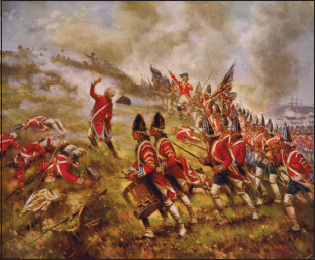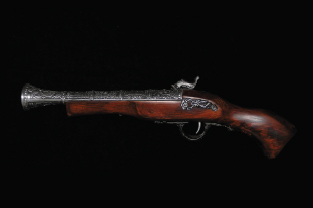2. Gunpowder!
The explosive “Chinese snow” appeared in fireworks a couple of centuries before Roger Bacon, an English friar and philosopher, described gunpowder in 1249. But those first compounds were hardly reliable propellants. Also, the idea of bottling gas pressure from burning powder and directing a projectile from a barrel had yet to be explored. Not until the early fourteenth century would crude guns appear in England, following experimental work on propulsion by Berthold Schwarz. In 1327 Edward II used guns as weapons during his invasion of Scotland.
Early gunpowder comprised roughly 40 percent saltpeter, with equal proportions of charcoal and sulfur. In 1338 French chemists changed the composition to 50-25-25. The English later settled on a mix of 75 percent saltpeter, 15 percent charcoal and 10 percent sulfur. That composition became established as black powder until the development of guncotton in 1846.
Powder manufacture in the US antedated gun-building. A powder mill in Milton, Mass., near Boston, was probably the first such facility. By the beginning of the Revolution, enterprising colonists had amassed, by manufacture or capture, 40 tons of black powder! Half went to Cambridge, where it was wasted before George Washington took charge of the Revolutionary Army. In short order, the Continental Army had no powder at all! New mills became a top priority, and by war’s end American forces had stocks of powder totaling 1,000 tons. By 1800 the new nation’s powder mills were producing 750 tons annually.

Roger Bacon, friar and philosopher, wrote descriptions about gunpowder in the 13th century, more than 400 years after its invention in China.
Igniting black powder was easy in open air, not so easy in a chamber that bottled the expanding gas to launch a ball. The first guns, developed in Europe a century and a half before Columbus sailed for the New World, were heavy tubes that required two attendants. The Swiss called these firearms culverins. The culveriner held the tube, while his partner, the “gougat,” lit a priming charge with a smoldering stick or rope. Culverins were clumsy and inaccurate and often misfired. Still, the noise and smoke they generated could unnerve an enemy armed with spears or pikes or even bows. Culverin muzzles were also fitted with ax heads, to make them useful when ignition failed. Eventually these firearms were modified so one soldier could load and fire unassisted. Mechanical rests helped shooters steady the heavy barrels. A forked brace adapted from fourteenth century artillery supported the petronel, a hand cannon held against the breast for firing. Forks could be made to support infantry guns or even used on the saddle of a mounted soldier.

In the Revolutionary War, British troops were no match for the French-style flintlocks favored by the Americans.
Stationary guns aimed at a wall or a mass of men could be fired without regard to timing because gun and target had a fixed relationship. But soldiers on the move could ill afford to wait for a wick to burn through to the charge. They needed a mechanism to cause instant ignition. The first lock was a crude lever by which a long, smoldering wick was lowered to the touch-hole in the barrel. This wick was later replaced by a shorter wick or match that got help from a cord kept smoldering atop the barrel. The shooter eased a serpentine device, holding the match, onto the cord until the match caught fire. Then he moved it to the side and lowered it to the touch-hole. A trigger adapted from crossbows afforded more control.

A Spanish arquebus, one of the first matchlocks.
Guns with this crude mechanism became known as matchlocks. The Spanish arquebus was one. Arquebusiers carried extra wicks smoldering in perforated metal boxes on their belts. But no preparation could ensure steady or reliable discharges. In 1636, during eight hours of battle at Kuisyingen, one soldier managed only seven shots! At Wittenmergen two years later the rate of fire doubled to seven shots in four hours. Eliminating the wick became the priority of sixteenth century German gun designers, who developed the “monk’s gun” with a spring–loaded jaw that held a piece of pyrite (flint) against a serrated bar. To fire, the shooter pulled a ring at the rear of the bar, scooting it across the pyrite to produce sparks. The sparks fell in a pan containing a trail of fine gunpowder that entered the barrel’s touch-hole. This design led to another, in Nuremberg, around 1515. The wheellock had a spring–loaded sprocket wound with a spanner wrench and latched under tension. Pulling the trigger released the wheel to spin against a fixed shard of pyrite held by spring tension against the wheel’s teeth. Sparks showered into the pan. Wheellocks were less affected by wet weather than were matchlocks. They also gave quicker ignition and were faster to set.

White smoke from black powder: at ignition, a flintlock’s discharge can obscure the target.

After lifting thumbing frizzen (left) and hammer, a shooter charges a flintlock pan and touch-hole with powder. The frizzen is then lowered. The hammer’s flint strikes it, sparks firing the powder.
In the Lock a la Miquelet, the roles of pyrite and steel were reversed. Named after the Spanish miquelitos (marauders) operating in the Pyrenees, this design appears to have Dutch origins. It would later be modified to become what we Americans know as the flintlock. Guns of this type have a spring–loaded cock that holds a piece of flint and swings in an arc when released. At the end of its travel, the flint in the jaws of the cock hits a pan cover or hammer, knocking it back to expose the primed pan. Sparks shower into the pan, igniting a charge of priming powder, which conducts flame through the touch-hole. The cock eventually became known as a hammer, the hammer a frizzen. Flintlocks were less expensive to build than were wheellocks and in time proved more reliable.
The common weakness of matchlock, wheellock, and flintlock mechanisms was exposed priming. It was vulnerable to moisture which could quickly render the gun useless. A weak spark might fail to ignite even dry priming. If it did ignite, flame might not reach the main charge, yielding only a “flash in the pan.” Generating spark inside the gun became possible early in the eighteenth century, with the discovery of fulminates. Chemists found that fulminic acid (an isomer of cyanic acid) produced shock sensitive salts. A sharp blow caused them to release their energy immediately and more reliably than flint generated sparks. In 1774 the chief physician to Louis XV wrote about the explosiveness of mercury fulminate. Adding saltpeter to fulminates of mercury produced a shock sensitive but stable explosive. Called “Howard’s powder” after Englishman E. C. Howard who discovered it in 1799, this compound may have figured into experiments by Scotch clergyman Alexander John Forsythe. In 1806 Forsythe became the first on record to ignite a spark in the chamber of a gun. Two years later the Swiss gun maker Johannes Pauly designed a breech–loading percussion gun that employed a cartridge with a paper percussion cap on its base. A spring–loaded needle pierced the cap, detonating the fulminate. The Lefauchex needle gun came later.
Clearly a landmark development, the advent of internal combustion drew enormous interest from military and civilian circles. New ammunition and guns to fire it were developed simultaneously by legions of inventors. In 1818 Joseph Manton, an Englishman, built a gun with a spring–loaded catch that held a tiny tube of fulminate against the side of the barrel over the touch-hole. The hammer crushed the fulminate, and breech pressure blew the tube off to the side. The Merrill gun, 14,500 of which were bought by the British government, featured this mechanism. In 1821 the London firm of Westley Richards designed a percussion gun that used fulminate primers in a flintlock–style pan. The pan cover, forced open by the falling hammer, exposed a cup of fulminate. The hammer’s sharp nose pierced it. Two years later American physician Dr. Samuel Guthrie found a way to make a much more convenient fulminate pellet.
Though many inventors have claimed credit for the percussion cap, its development is most commonly attributed to sea captain Joshua Shaw of Philadelphia. In 1814 Shaw was denied a patent for a steel cap because he was British–born and yet to become an American citizen. He persevered with a disposable pewter cap then one made of copper. The hollow nipple appeared soon. It provided a tunnel that caught sparks at their origin and funneled them to the chamber. In 1822 Shaw patented his own lock. Twenty-four years later, Congress awarded the 70-year-old inventor an honorarium for his work.
Between 1812 and 1825 the US patent office issued 72 patents for percussion caps. Only a few proved out. Some caps fragmented, splattering the shooter. Others had so little priming mixture they failed to ignite the main charge—or so much they started the ball before the burning powder could build pressure. To throttle primer blast, an Englishman named Nock designed an antechamber perpendicular to the bore and behind the chamber. Powder burning there ignited the main charge through a short tunnel.
Oddly enough, percussion rifles were slow to gain acceptance. In the early nineteenth century, chemistry was still viewed with suspicion by the masses, and fulminates were chemicals. Also, some early caps produced erratic results. Governments resisted replacing pyrite. Flintlocks, after all, had been refined mechanically and esthetically. Besides, percussion guns were rumored to kick harder while delivering a weaker blow downrange. Even Britain’s Colonel Hawker, a firearms authority, throttled his praise of percussion ignition: “For killing single shots at wildfowl rapidly flying, and particularly by night, there is not a question in favor of the detonating system, as its trifling inferiority to the flint gun is tenfold repaid by the wonderful accuracy it gives in so readily obeying the eye. But in firing a heavy charge among a large flock of birds the flint has the decided advantage.”
Eventually percussion caps would win over the doubters. Meanwhile, firearms were changing in other ways. The Pilgrims had landed with unwieldy smoothbores, typically 6 foot long .75-caliber flintlocks. Though the superior accuracy of rifled bores was well known by that time (rifle matches had been held as early as 1498 in Leipzig, Germany, and 1504 in Zurich, Switzerland), rifled barrels were expensive and slow to load. But in the New World, battles between settlers and Indians did not follow the traditional European pattern. There was no wall of uniforms, squarely presented as a collective target. The enemy was commonly a single antagonist, partly hidden behind vegetation. Accuracy mattered to soldiers and hunters alike. Then too, the huge lead balls used in British muskets constituted a waste of valuable lead. For these reasons, Americans came to favor the French-style flintlock popular in Europe at the beginning of the eighteenth century. From it evolved the jaeger (hunter) rifle. The typical jaeger had a 24 to 30 inch barrel of .65 to .70-caliber, with seven to nine deep, slow–twist grooves. Most wore a rectangular patch box on a stock with a wide, flat butt. Double set triggers were common. To conserve lead, frontier gunsmiths started making jaegers with .50–, .45–, even .40–caliber bores. (A pound of lead will yield 70 .40–caliber balls, but only 15 of .70 inch diameter.) They lengthened the barrel, replaced the jaeger’s sliding patch box cover with a hinged lid and trimmed the stock, giving it a “crescent” butt to fit comfortably against the shooter’s upper arm. The result became known as the Kentucky rifle, though most of the changes were wrought in Pennsylvania by riflesmiths of German extraction.
The jaeger’s rifled bore made it much more accurate than the Brown Bess musket British troops brought to the Revolutionary War. To speed loading, Americans learned early on to swath undersize balls in greased patches that took the rifling. Strangely, the crack Jaeger troops against whom they also fought, still loaded their rifles with tight–fitting balls. The colonists beat the Jaegers almost as handily as they defeated British regulars. The patched ball soon emerged as a standard for hunters, who appreciated the cleaning action of the patch and its protection of the bore against leading.
Table of contents
- Title Page
- Dedication
- Copyright
- Acknowledgments
- Foreword
- CONTENTS
- INTRODUCTION
- SECTION I: BALLISTICS IN HISTORY
- SECTION II: THE MUSCLE BEHIND THE SHOT
- SECTION III: BULLETS—THE INSIDE STORY
- SECTION IV: SPEED, ENERGY, AND ARC
- SECTION V : PUTTING BALLISTICS TO WORK
- SECTION VI: FOR LONGER REACH
- BALLISTICS TABLES FOR MODERN SPORTING RIFLES
- GLOSSARY